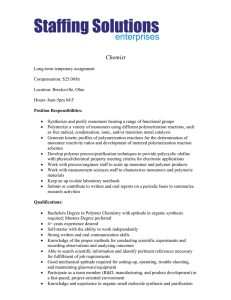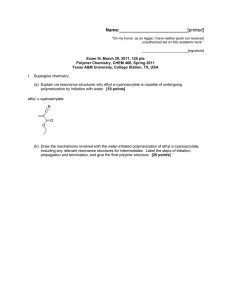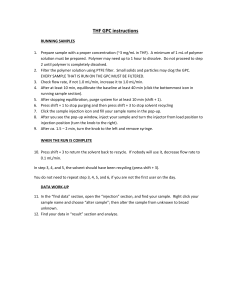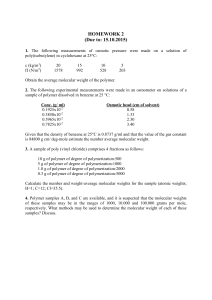Document 13223458
advertisement
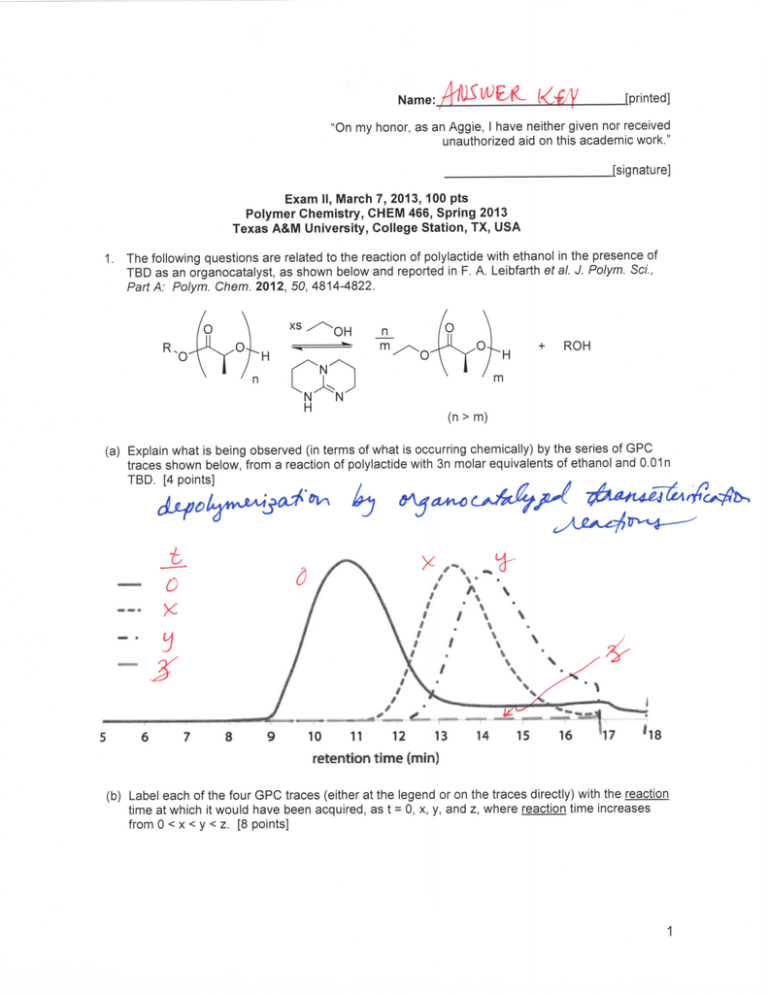
Jprinted]
Name:
"On my honor, as an Aggie, I have neither given nor received
unauthorized aid on this academic work."
[sig natu re]
Exam II, March 7, 2013,100 pts
Polymer Chemistry, CHEM 466, Spring 2013
Texas A&M University, College Station, TX, USA
1.
The following questions are related to the reaction of polylactide with ethanol in the presence of
TBD as an organocatalyst, as shown below and reported in F. A. Leibfarth et a/. J. Polym. Sci.,
Part A: Polym. Chem. 2012, 50, 4814-4822.
ROH
(n > m)
(a) Explain what is being observed (in terms of what is occurring chemically) by the series of GPC
traces shown below, from a reaction of polylactide with 3n molar equivalents of ethanol and 0.01n
TBD. [4 points]
C/
jfc.
0
,
•
10
11
retention time (min)
(b) Label each of the four GPC traces (either at the legend or on the traces directly) with the reaction
time at which it would have been acquired, as t = 0, x, y, and z, where reaction time increases
from 0 < x < y < z. [8 points]
[printed]
Name:
(c) Draw a schematic illustration of the components that comprise a GPC system. [14 points]
(d) Indicate the parameter that determines the retention time that a molecule experiences during
analysis by GPC, how the magnitude of the value for that parameter affects the retention time,
and why. [6 points]
(e) Given the 1H NMR spectrum below, calculate the average degree of polymerization, m. A few
notes: there are 2 inset spectra that are simply expanded views of regions of the entire spectru
(note the scale to identify the regions); integrals are not drawn on the spectrum, rather the
integration values are given below each set of peaks; there are multiple signals (sets of
each type of proton of the structure, so please review carefully the assignments that are made on
the structure; recall the reaction that generated this sample—it makes the problem a bit tricky. [8
points]
A <f{ -H>I4 W p*t
f+9
(not observed)
a+b
5.2
5.0
4.8
4.6
8
ci
6.0
5.5
5.0
4.5
4.4
i
4.0
4.2
4.0
EtOH
1.5
1.4
1.3
1.2
TBD
3.5
3.0
ppm
2.5
20
1.5
1.0
05
forintedl
2.
For the chain-growth polycondensation polymerization reported in T. Yokozawa et al. J. Am.
Chem. Soc. 2000, 122, 8313-8314, employing an activated form of 1a as the monomer and 2 as
the initiator, as illustrated below, controlled polymerization was confirmed to afford well-defined
polyamide products.
CV*-\/
2
C"^-^
^N-IT^- C-OPh
ng EDG
stroTUTfv'
less
C-OPn
ii
0
reactive
reactive
A _
la
C-OPh —••»•»'
it
0
0,N
weakEDG
polyamide product
reactive
R = n-C8H17: EDG - Electron-donating group
As one of the techniques applied to confirm controlled "livingness" of the polymerization, an initial
prepolymer was prepared and then an additional aliquot of monomer was added.
(a) Draw the chemical structure for the initial prepolymer (the "polyamide product" in the scheme
above). [4 points]
(b) Draw the chemical structure for the final polymer that would result after the introduction of
additional monomer. [4 points]
?6
Name:
[printed]
(c) Indicate on the figure below, containing overlaid GPC traces, which trace would be generated by
the prepolymer and which would be generated by the final polymer (the y-axis is not shown, but it
is simply the detector response). [4 points]
16.00
18.00
Eimion volume, ml
(d) Describe two characteristics of this final polymer, revealed in the overlaid GPC traces above, that
allowed for confirmation of the controlled "livjngness" of the polymerization. [4 points]
(e) Using similar concepts to those above, provide a retrosynthetic pathway for the preparation of t
following block copolymer. [8 points]
Name:
3.
[printed]
Directly on the schematic illustrations of a DSC trace (Figure 12.6 of your textbook—please note
that the heat flow axis is opposite to that discussed during lecture) and polymer chain packing
(Figure 13.15 of your textbook) shown below:
t
o
1
Temperature (*
(a) Label the thermal transitions along the DSC trace, including their types (e.g. Tm, Tg, Tc). [6
'points]
\) Identify (with a line extending from the trace to the temperature axis) the positions along the
DSC trace at which the temperature value for each transition would be measured. [6 points]
(c) Indicate the physical states of matter that are expected to be present in the sample at the
various temperature ranges along the DSC trace. [8 points]
(d) Label the physical states of matter within the regions of the polymer chain packing structure
below, as being either crystalline or amorphous. [4 points]
[printed]
Name:
For the chemical reaction, showing partial deprotection of a poly(quinic acid carbonate) by
removal of a portion of the fert-butyldimethysilyl (TBS) ether protecting groups to give hydroxyl
functionalities, and accompanying DSC traces:
= H (59 %)
= TBS (41%)
50
100
150
200
Temperature
(e) Use arrows to point each chemical structure to its corresponding DSC trace. [4 points]
(f) State how the assignments of structures to traces was made, i.e. state which characteristics
of the structures/compositions would lead to a higher or lower Tg value and why. [4 points] ^
»*
(g) Interpret the DSC traces (show your work for the analysis), to provide an estimation of the Tg
values for both traces. [4 points]
6
Name: _
[printed]
Equations, which may be of use:
Number-average molecular weight:
N x = # moles of polymer chains having molecular weight, Mx
Weight-average molecular weight:
M w = Ew x M x =
EN X M X
wx = wt fraction of polymer chains having molecular weight, M x =
NXMX
SN X M X
Degree of polymerization:
1-c
c = extent of conversion of functional groups
Polydispersity index:
Critical extent of reaction:
2
Pc =
fav
Average degree of monomer functionality:
Textbook:
Hiemenz, P. C.; Lodge, T. P. Polymer Chemistry, 2nd Edition; CRC Press, Taylor &
Francis Group: Boca Raton, FL, USA, 2007
![Name:___________________________ “On my honor, as an Aggie, I have neither given... unauthorized aid on this academic work.” ________________________[signature]](http://s2.studylib.net/store/data/013223457_1-e567749bf987f0b6adc5f0f5d73a0126-300x300.png)


